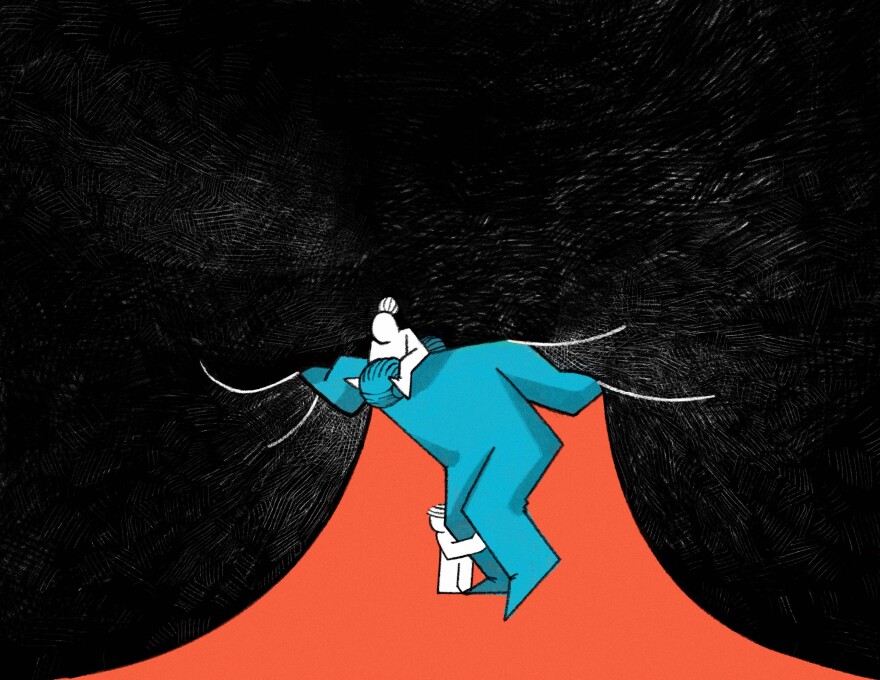Truth matters. Community matters. Your support makes both possible. LAist is one of the few places where news remains independent and free from political and corporate influence. Stand up for truth and for LAist. Make your tax-deductible donation now.
Paid COVID-19 Leave Offered Parents Relief. It Expires December 31

Since February, California workers have had an additional 80 hours of paid leave related to COVID-19.
That policy ends Dec. 31 even as coronavirus infections and deaths in L.A. County hit their highest rates since the summer. This winter has also seen a surge in other respiratory illnesses.
“It's incredibly important for workers to have time off to care for themselves and for their family members when they're sick, to allow them to continue working, to allow them to be able to sustain themselves and their families through their livelihood,” said Legal Aid At Work staff attorney Sela Steiger.
How to Claim COVID-19 Paid Sick Leave
Many California workers can get coronavirus sick pay through January if they start their claim on or before Dec. 31. Read more from our friends at KQED.
The additional paid leave was an especially important resource for California parents who could use the time to care for their kids or take them to be vaccinated against the virus.
“It felt like a form of support from the government and my job during a real-life hardship— which felt really rare,” said Duarte mom Sofia Guevara.
For Parents, ‘Time Is Such A Precious Resource’
In November, Guevara’s 8-month-old-son Vincent got COVID-19. He was feverish, and had a slight cough and trouble sleeping.
“He did seem to be really uncomfortable, which makes me think that he had the aches and pains,” Guevara said. At one point, Guevara took the baby to the emergency room. Doctors didn’t admit Vincent, but prescribed additional medication.
Guevara and her husband also tested positive for the virus. She used COVID-19 leave to take about a week off from her job at a health insurance provider.
“Time is such a precious resource,” Guevara said before pausing to collect her emotions.
Guevara said typically she gets three paid sick days a year— California’s minimum— and otherwise dips into her paid time off.
“You either get the time to take care of yourself or a family member, or you get a vacation,” Guevara said.
With two weeks worth of COVID-19 leave, Guevara didn’t worry about falling behind at work or losing income from taking unpaid leave.
“When I look back on it, it's not like a dark time, it was a time where I feel like I could properly nurture my baby,” Guevara said.
With the hours she had left after the family recovered, Guevara got the most recent COVID-19 booster shot.
How Can I Take Sick Leave Now?
Many California workers can get coronavirus sick pay through the new year if they start a claim before or on Dec. 31. For example: If you test positive for COVID-19 on Dec. 31 and contact your employer (ideally, in writing) that day, you can still claim the benefit.
After the COVID-19 leave expires, that leave becomes regular paid sick leave.
California is among 17 states with a paid sick leave mandate.
RESOURCES
These resources were recommended by California legal experts, birth workers and families. Have a suggestion? Email sritoper@scpr.org.
Work and family basics and help
- Legal Aid at Work: Helpline to get pro-bono legal advice and information about sick leave. Call 800-880-8047.
California Laws that protect your time off
Programs for pay while you take leave
- State Disability Insurance
- Paid Family Leave
- Guide for family leave for undocumented workers
- EDD phone numbers to talk to someone about State Disability Insurance or Paid Family Leave
Share your story to make a change
One San Gabriel Valley father told LAist caring for his 5-year-old-daughter, let alone himself, more than exhausts the paid time off he earns every year. LAist agreed not to share his name so he could speak freely about his employer.
He estimated his daughter gets sick at least once a month. Earlier this year she had the respiratory virus RSV.
“I've had to lie at times to say that I'm sick so that I can stay home [and work remotely] … so that I can take care of my own kid because I've got nobody to look after her,” he said.
The father exhausted the COVID-19 sick leave this year when his entire family caught the virus.
“I like to joke around with all my friends and family that I'm grateful that we don't have another kid but in reality we want another child,” the San Gabriel Valley father said. “We just cannot afford it.”
California lawmakers passed laws this year that increased the amount of money people get while taking paid family leave and expanded caregiving leave to cover chosen and extended family.
“People shouldn't have a barrier when they go to apply for leave,” said Jenya Cassidy, director of the California Work and Family Coalition. Those barriers can also include difficulty reaching the agency that oversees leave by phone or getting help in a person’s primary language.
We really advocate for workers not having to make that choice between going to work sick, or sending their child to school sick, and being able to provide for themselves and their family through their income.
Advocates said they will push for an expansion of paid leave next year. Several states, including Maryland, New Mexico and Colorado, offer five days or more of paid sick leave a year.
“We really advocate for workers not having to make that choice between going to work sick, or sending their child to school sick, and being able to provide for themselves and their family through their income,” Steiger said.








